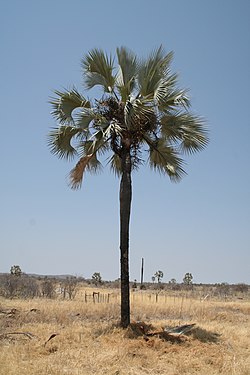| Hyphaene petersiana | |
|---|---|
 | |
 | |
| Specimen in northern Namibia, and the spherical fruit with cross-section | |
| Scientific classification | |
| Kingdom: | Plantae |
| Clade: | Tracheophytes |
| Clade: | Angiosperms |
| Clade: | Monocots |
| Clade: | Commelinids |
| Order: | Arecales |
| Family: | Arecaceae |
| Genus: | Hyphaene |
| Species: | H. petersiana |
| Binomial name | |
| Hyphaene petersiana | |
| Synonyms [1] | |
| |
Hyphaene petersiana, the real fan palm or makalani palm, is a palm tree native to the subtropical, low-lying regions of south central Africa.



